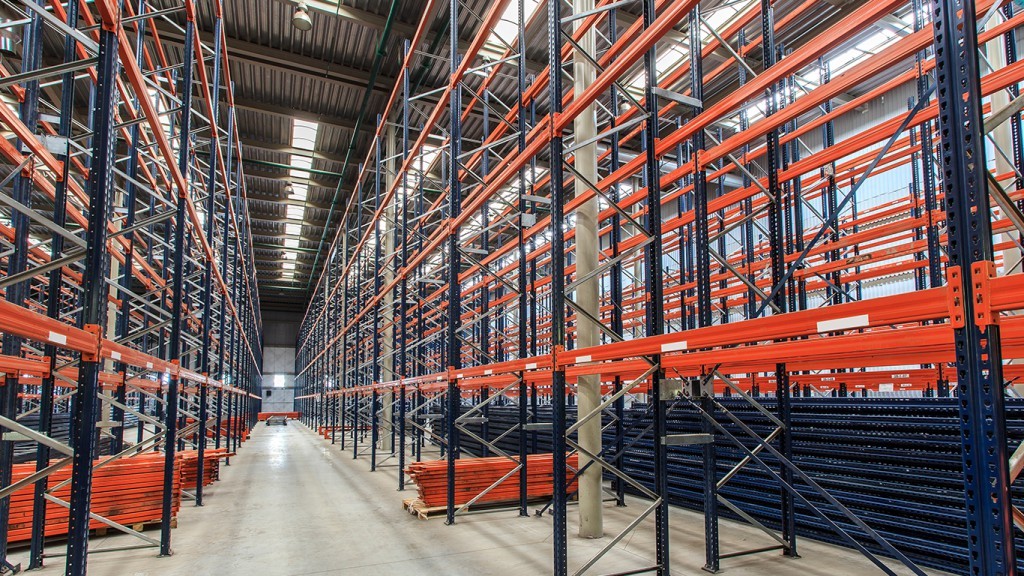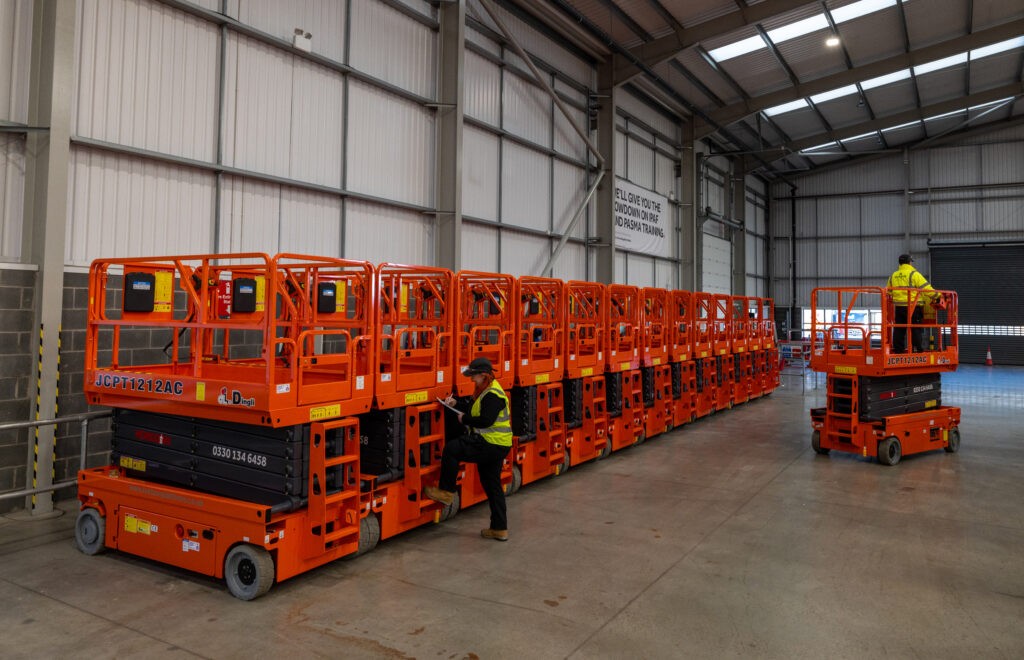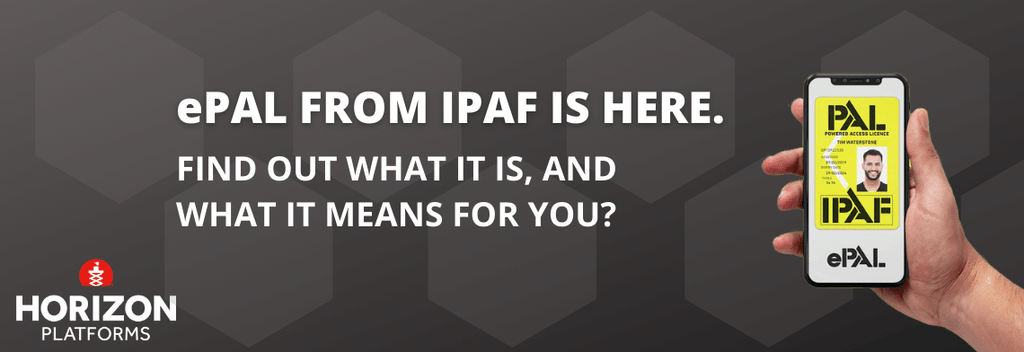You may not be aware, but you could be breaking health and safety rules on a daily basis. Health and Safety compliance is a necessity when engaging in work-at-height tasks and using a cherry picker or scissor lift plays a huge part in keeping people safe. Ignoring these rules can result in severe penalties, lawsuits, and even imprisonment and can lead to tragedy.
It’s fundamentally important for employers and operators to understand the basic health and safety guidelines when working at height and the seemingly minor yet crucial points that may be overlooked.
Here at Horizon Platforms, the safety of our customers and team members is a priority and we are passionate about ensuring that our equipment is used safely. As such, we have gathered a checklist of vital work-at-height health and safety regulations to ensure you and your staff’s well-being while operating a MEWP (mobile elevating work platform), featuring those essential yet minimalistic details you may need to be made aware of.
Read on to find out which health and safety rules you could be breaking without realising…
Do You Know What Personal Protective Equipment (PPE) You Need?
You’re likely aware that proper use of personal protective equipment is crucial to working at height safely. However, you may not know what specific PPE you need or indeed need a refresher. The PPE used when working at height is called PFPE (personal fall protection equipment). The following are some PFPE items that should be worn when using our equipment:
Harness
A full body harness with five points of contact – to fully support the body in case of a fall, which sits over both shoulders, around both legs and around the wearer’s waist, is essential for boom lift fall protection. You can find harnesses amongst our access platform accessories.
We also provide training on the use and inspection of safety harnesses.
Lanyards
The individual working at height wears the harness and attaches it to a restraint lanyard, which fastens it to an anchor point. The restraint lanyard should be adjusted to be short enough to prevent a fall. A MEWP lanyard allows you to move freely without needing additional support.
Do You Know How Often You Should Inspect Your Equipment?
All equipment used at height must be carefully and regularly inspected for faults that may prove hazardous to worker’s safety. However, you may not realise how regularly you should be inspecting your work from height equipment.
MEWP Inspection
Making sure that your MEWP is in perfect working order is far more important than you may realise. For safe use of MEWPs such as cherry pickers or scissor lifts, you must inspect your equipment. A pre-use checklist can be found in the operator manual or you can use the IPAF pre-use inspection checklist. If any issues are discovered, report them and only use your MEWP once a specialist has examined them.
In the unlikely event of equipment failing, when you hire from Horizon, you will have access to a specialist on the phone within fifteen minutes, and we can have an engineer onsite in three hours when necessary. Support is also offered 24/7, so you can contact us outside of usual business hours if needed.
Lifting Operations and Lifting Equipment Regulations (LOLER) 1998 states that MEWPs should go through a thorough examination every six months. There should be evidence on the MEWP to identify when the last thorough examinations took place and when the next thorough examination is due. Horizon provides a copy of the report of thorough examination with every machine.
However, if an incident occurs on site that may impact the safety of the MEWP, it is essential the customer contacts Horizon so we can arrange a safety inspection and if necessary, complete a thorough examination of the machine.
On top of this, purchasing or hiring your MEWP from an accredited supplier is always the safest and most sensible choice. All of our MEWPs are put through a thorough pre-delivery inspection (PDI) to reduce the risk of any surprises and we pride ourselves on being industry leaders in standards and quality checks, so any cherry picker or scissor lift hired from us comes with that additional peace of mind.
If you are still unsure of how to carry out a pre-use inspection for scissor lift or cherry picker safety, we have a guide to walk you through the process in more detail.
PFPE Inspection
PFPE inspections are to be performed in compliance with BS EN 365:2004 and BS 8437:2005. Meaning PPE must be inspected every twelve months or more frequently if exposed to extreme environments. But at Horizon Platforms, to avoid devastating accidents, we would suggest you check equipment before each use as part of a robust risk assessment.
Are You Securing Tools and Equipment to MEWPs?
Tools and equipment not being properly stored create a slip-and-trip hazard, which could cause a worker to trip or fall. It could also result in the tool itself falling from the MEWP and hitting someone below. Therefore, it is important to safely store all tools and equipment for proper scissor lift and cherry picker safety. This can be accomplished with tool belts and dedicated storage spaces.
Are You Overloading Platforms?
Overloading an access platform is extremely dangerous as it could damage the structural integrity of the platform or result in a MEWP overturning or tipping. Preventing an overload can be done by checking the Safe Working Load (SWL) in the machine’s operator manual, which is supplied with each MEWP. If this is missing, you shouldn’t use the platform until you have contacted the supplier to obtain the platform’s specification and SWL.
The SWL outlines the maximum weight for operating the lifter. You can ensure you don’t exceed the SWL by accurately calculating the weight of all items and equipment and considering the weight of the people working on the platform. It’s also important to note that the load should not extend beyond the platform edge or lean against the guardrails.
Do You Make Sure You Check The Weather Conditions Before Working At Height?
Weather conditions can significantly impact the safety of working at height, though this is often underestimated.
Windspeed
Working on a cherry picker, scissor lift or other MEWP in windy conditions can be dangerous. Many MEWPs are designed for indoor use only with a max-rated wind speed of 0mph. However, each MEWP is different and the wind speed limit for each can be found on the manufacturer’s data plate and in the operator’s manual and there should also be a max wind speed decal clearly visible on the machine.
For further advice, check out our blog post on wind safety.
Freezing conditions
Snow and ice present a considerable slip risk, so ensure that all cherry pickers, scissor lifts and walkways are cleared. Heavy snow and ice can also cause damage to MEWPs and height safety systems, so full inspections should be carried out before use as, in some cases, work may not be advisable and will have to be put on hold for the safety of others. Freezing conditions can also affect the movement and response of the controls, so it is essential to do pre-use checks of all functions prior to use in inclement weather.
Thunder and Lighting
If there is evidence of thunder and lightning in your area, all outdoor work from height should stop immediately.
Are You Working Alone on a MEWP?
Working from height alone should be avoided as much as possible. Additional persons can help to spot hazards, advise or remind of health and safety procedures and help with difficult tasks. They can also provide first aid or call for help should an incident occur.
The Work at Height Regulations mandate a rescue plan is in place for any work at height. Hence it is essential that a nominated ground rescue person is available in the vicinity of any work at height. Workers should not operate on a site alone. Before any lone working at height takes place, managers and operators should ensure a robust risk assessment has identified a safe system of work to ensure all health and safety requirements are considered and adhered to.
Are You Aware of Traffic?
If you are operating your MEWP in a public area, highway or construction site, you should have vigilant awareness of the vehicles around you, as IPAF‘s Global safety report noted a significant 38 incidents involving vehicle or machine collisions in 2022, worldwide.
Are You Conducting Risk Assessments?
HSE legally requires risk assessments to be performed before any work from height takes place. This means:
- Identifying the hazards, such as the work environment and equipment used.
- Assessing the risks, such as by considering who might be harmed and how.
- Deciding what should be done to control the risk. If possible, eliminate the hazard. If this is not possible, reduce the risk as much as possible.
To help you, we’ve compiled a list of common risks when working with MEWPs.
Are You and Your Workers Sufficiently Trained?
Training is essential for working at height, and it’s important to understand exactly how much training is needed for each task or piece of equipment. For some work at height equipment, such as a ladder, training does not need to be formal and can happen on the job. On the other hand, structured operator training is absolutely necessary before using a MEWP. IPAF worldwide data shows that in the vast majority of cases, operators having accidents have yet to undergo structured training.
If a casualty occurs from a lack of sufficient training, this creates a personal tragedy and significant legal trouble for the employer. As our training manager, Ben Hughes points out:
“It is essential that operators are trained to a competent standard for the safety of everyone concerned. If they aren’t adequately trained, with evidence to back it up, proving that in a court of law or a tribunal would be extremely difficult and could result in a large fine or jail time, or both!”
Therefore, we highly recommend providing fully IPAF-accredited training. This helps to protect the employer and the company should the worst-case scenario occur, as thorough and accredited training records can be supplied as evidence of adequate training in a police investigation.
In addition to operators being fully trained, managers must also undertake health and safety and work-from-height training in order to have their operator’s backs, ensure risk assessments and rescue plans are airtight and correctly oversee all MEWP work. We have MEWPs for managers training for this purpose.
It is important to note that IPAF and training certificates must be renewed every five years.
We happily provide a variety of detailed and extensive IPAF training courses for our clients, so speak with your manager if you are not currently trading with Horizon.
If you’re still unsure about how to protect the health and safety of yourself and your workers when working from height, feel free to contact us for more advice or consult our blog.



